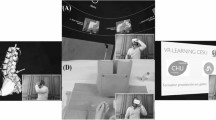Abstract
Training in medical practices requires materials, patients and a context that allows students to become familiar with the environment and tools. However, this is not always easy to achieve. Immersive virtual reality can be a suitable tool for moving from theoretical studies to practice in a real context. This paper describes the process of analysis, design and development of a virtual environment in which lumbar puncture can be performed. It is a project in development that combines medical research with the latest advances in extended reality to improve the training possibilities of medical students.
Access this chapter
Tax calculation will be finalised at checkout
Purchases are for personal use only
Similar content being viewed by others
References
dos Anjos, F.E.V., Rocha, L.A.O., da Silva, D.O., Pacheco, R.: Impacts of the application of virtual and augmented reality on teaching-learning processes in engineering courses: a systematic literature review about learning and satisfaction on students. Int. J. Virt. Person. Learn. Environ. (IJVPLE) 12(1), 1–19 (2022)
Araiza-Alba, P., Keane, T., Chen, W.S., Kaufman, J.: Immersive virtual reality as a tool to learn problem-solving skills. Comput. Educ. 164, 104121 (2021). https://doi.org/10.1016/j.compedu.2020.104121. https://www.sciencedirect.com/science/article/pii/S0360131520303195
Bostrom, M., Singh, S.K., Wiley, C.W.: Design of an interactive lumbar puncture simulator with tactile feedback. In: Proceedings of IEEE Virtual Reality Annual International Symposium, pp. 280–286. IEEE (1993)
Bott, O., et al.: VirtX-evaluation of a computer-based training system for mobile C-arm systems in trauma and orthopedic surgery. Methods Inf. Med. 47(03), 270–278 (2008)
Cheng, Z., Wang, H., Min, Y., Yan, Z., Hong, Z.T., Zhuang, T.: Preliminary study on force feedback of acupuncture in virtual reality based on the visible human. Zhongguo yi Liao qi xie za zhi= Chin. J. Med. Instrument. 31(1), 5–9 (2007)
Dang, T., Annaswamy, T.M., Srinivasan, M.A.: Development and evaluation of an epidural injection simulator with force feedback for medical training. In: Medicine Meets Virtual Reality 2001, pp. 97–102. IOS Press (2001)
Dreifaldt, U., Kulcsar, Z., Gallagher, P.: Exploring haptics as a tool to improve training of medical doctors in the procedure of spinal anaesthetics. Eurohaptics 2006 (2006)
Färber, M., Hummel, F., Gerloff, C., Handels, H.: Virtual reality simulator for the training of lumbar punctures. Methods Inf. Med. 48(05), 493–501 (2009)
Gorman, P., Krummel, T., Webster, R., Smith, M., Hutchens, D.: A prototype haptic lumbar puncture simulator. In: Medicine meets virtual reality 2000, pp. 106–109. IOS Press (2000)
Henriksen, M.J.V., Wienecke, T., Kristiansen, J., Park, Y.S., Ringsted, C., Konge, L.: Opinion and special articles: stress when performing the first lumbar puncture may compromise patient safety. Neurology 90(21), 981–987 (2018)
Kanumuri, P., Ganai, S., Wohaibi, E.M., Bush, R.W., Grow, D.R., Seymour, N.E.: Virtual reality and computer-enhanced training devices equally improve laparoscopic surgical skill in novices. JSLS: J. Soc. Laparoendoscopic Surg. 12(3), 219 (2008)
Leung, K.M., Heng, P.A., Sun, H., Wong, T.T.: A haptic needle manipulation simulator for chinese acupuncture. Studies in Health Technology and Informatics, pp. 187–189 (2003)
Pirker, J., Dengel, A., Holly, M., Safikhani, S.: Virtual reality in computer science education: A systematic review. In: VRST 2020: Proceedings of the 26th ACM Symposium on Virtual Reality Software and Technology. VRST 2020, Association for Computing Machinery, New York, NY, USA (2020). https://doi.org/10.1145/3385956.3418947
Radianti, J., Majchrzak, T.A., Fromm, J., Wohlgenannt, I.: A systematic review of immersive virtual reality applications for higher education: design elements, lessons learned, and research agenda. Comput. Educ. 147, 103778 (2020). https://doi.org/10.1016/j.compedu.2019.103778. https://www.sciencedirect.com/science/article/pii/S0360131519303276
Schulze, A.N.: User-centered design for information professionals. J. Educ. Libr. Inf. Sci. 42, 116–122 (2001)
Wright, B.L., Lai, J.T., Sinclair, A.J.: Cerebrospinal fluid and lumbar puncture: a practical review. J. Neurol. 259, 1530–1545 (2012)
Acknowledgements
Research supported by the e-DIPLOMA, project number 101061424, funded by the European Union. Views and opinions expressed are, however, those of the authors only and do not necessarily reflect those of the European Union or the European Research Executive Agency (REA). Neither the European Union nor the granting authority can be held responsible for them.

Research is also supported by the UJISABIO program, related to the project (UJISABIO22-AP07) “3D design and virtual reality applied to medical learning in emergencies and emergencies”.
Author information
Authors and Affiliations
Corresponding author
Editor information
Editors and Affiliations
Rights and permissions
Copyright information
© 2023 The Author(s), under exclusive license to Springer Nature Switzerland AG
About this paper
Cite this paper
Villar-López, M.B., Gómez-Cambronero, Á., Suarez, D., Remolar, I. (2023). Development of an Immersive Virtual Reality System to Practice the Lumbar Puncture Manoeuvre. In: Kubincová, Z., Caruso, F., Kim, Te., Ivanova, M., Lancia, L., Pellegrino, M.A. (eds) Methodologies and Intelligent Systems for Technology Enhanced Learning, Workshops - 13th International Conference. MIS4TEL 2023. Lecture Notes in Networks and Systems, vol 769. Springer, Cham. https://doi.org/10.1007/978-3-031-42134-1_10
Download citation
DOI: https://doi.org/10.1007/978-3-031-42134-1_10
Published:
Publisher Name: Springer, Cham
Print ISBN: 978-3-031-42133-4
Online ISBN: 978-3-031-42134-1
eBook Packages: Intelligent Technologies and RoboticsIntelligent Technologies and Robotics (R0)




